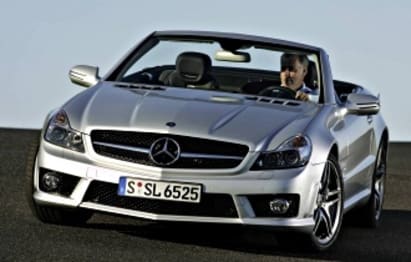
Mercedes-Benz SL sports an aggressive new look
- Mercedes-Benz SL-Class
- Mercedes-Benz SL55
- Mercedes-Benz SL-Class 2008
- Mercedes-Benz SL55 2008
- Mercedes-Benz SL-Class Reviews
- Mercedes-Benz SL55 Reviews
- Mercedes-Benz Reviews
- Mercedes-Benz Convertible Range
- Convertible
- Mercedes-Benz
- Prestige & Luxury Cars
Mercedes-Benz quietly admits that its look-at-me roadster had missed the mark.
The penny dropped for Mercedes, according to head of passenger car development Hans-Dieter Multhaupt, when 60 per cent of customers specified the AMG sports body kit for their basic SLs.
“That is not right,” Multhaupt says. “Normally, it should be 30 percent of customers who want the extra-sporty look."
“This tells us that the customer wants to have his car positioned a bit more sporty. This time, we have followed that wish.”
To that end, the revamped SL has a more powerful and efficient V6, optional active steering, a far more aggressive front end, a restyled interior and — oddly, given the customer message — a three-litre, entry-level V6.
“We felt we should sharpen the car's sporty edge,” Multhaupt says.
“Our customers expect from the SL a combination of sportiness, comfort and safety ... we felt it could be even a bit sharper in design and technology.”
Apart from the front and interior styling, the steering rack and the spanking 3.5-litre V6, most of the changes are, at best, subtle.
The SL's grille and general stance have been squared up to give the car a far more bulldog look.
Under the bonnet — which now features a pair of power bumps redolent of the original 1954 300SL — are a range of four engines from the entry V6 to the SL600's 5.5-litre V12.
“There are no immediate plans to add the SL280 to the Australian range, but it will remain under consideration,” Mercedes-Benz Australia's Peter Fedayev says.
Traditionally, the V8 SL500 has dominated Australian sales, but it could come under pressure from the SL350's high-spinning 3.5-litre V6.
With 232kW — up from 200kW in the superseded engine — and 360Nm of torque, the SL350 dispatches the sprint to 100km/h in 6.2 seconds and uses just 9.9 litres of fuel per 100km.
That's only marginally faster (0.4 of a second) and more efficient (0.4 of a litre) than the outgoing car, but it feels a whole lot better than those raw figures indicate.
Not so shabby for a middle-aged athlete in a corporate suit.
There are no changes to the engines at the top end of the bragging tree, with the 5.5-litre SL500 and twin-turbo, 5.5-litre V12 SL600 retaining their respective 285kW/530Nm and 380kW/830Nm outputs.
Most noticeable change to the cabin is the absence of the deeply scalloped dash, replaced by a flatter treatment with classic-styled dials and new three-spoke steering wheel.
As in some other performance models, including several from Subaru, the instrument needles flip from one side of the dial to the other on start-up before returning to their initial positions.
The seven-speed gearbox has not been changed, apart from a software upgrade that makes for slightly quicker changes in manual mode and blips the throttle on downshifts.
An unexpected advantage of that downshift blip is that the changes are smoother because of equalisation of shift pressure.
The chassis remains unchanged, but there has been some tweaking of the active body control (ABC) on the top-end cars to provide a sharper ride at full tilt; but a more refined suspension feel for general duties.
The biggest single difference to the upgraded SL is active steering — optional on models sold overseas but likely to be standard for those available in Australia.
At the heart of the variable steering is an idea first developed by Dr Arthur Bishop in Sydney almost 50 years ago.
“The beauty of Dr Bishop's idea was in its simplicity and economy,” Michael Rapp, senior manager for steering systems development at Mercedes-Benz, explains.
“There is no need to have sensors for speed input or servo motors or build in great complexity, which brings with it a greater risk of component failure ... the Bishop system is elegant simplicity."
“The benefit is that at highway speeds, the off-centre experience is sharp, yet in a situation like parking the greater assistance makes it easier to manoeuvre without needing to wind on great amounts of steering angle.”
Also optional on overseas models — and under consideration for Australia — are the Airscarf neck-warming system pioneered on the SLK and a multi-mode intelligent light system.
The system has five modes — country, motorway, enhanced fog lamps, cornering function and active function.
The variable-control bi-xenon headlamps activate the light functions automatically. Motorway mode, for example, kicks in at speeds in excess of 90km/h, increasing the driver's range of vision by up to 60 per cent.
When the active light function is operational, the headlamps pivot in line with the steering angle around bends, illuminating a claimed extra 25m.
“I think we now have a very good blend and the right mix for our customers,” Multhaupt says.
“They tell us all the time that they don't want a purist sporty car that you can only stand for an hour — the SL is a companion for the whole day."
“They want the sportiness at the same time as the comfort and the assurance of safety.”
Snapshot
Mercedes-Benz SL
Price: from $225,000 (est.) to $380,000 (est.)
Engine: 3.5L/V6, 232kW/360Nm (SL350); 5.5L/V8, 285kW/530Nm (SL500); 5.5L/V12, 380kW/830Nm (SL600)
Transmission: 7-speed automatic (SL350, SL500); 5-speed auto (SL600)
Pricing guides
Range and Specs
| Vehicle | Specs | Price* | |
|---|---|---|---|
| SL55 AMG | 5.4L, PULP, 5 SP | $57,750 – 66,330 | 2008 Mercedes-Benz SL-Class 2008 SL55 AMG Pricing and Specs |
| SL350 | 3.5L, PULP, 7 SP AUTO | $29,920 – 36,080 | 2008 Mercedes-Benz SL-Class 2008 SL350 Pricing and Specs |
$57,750
Lowest price, based on third party pricing data











